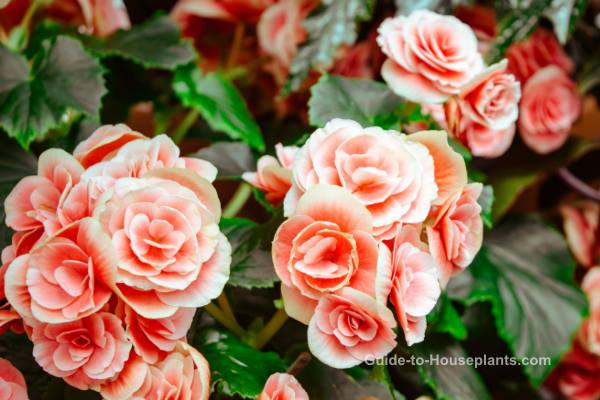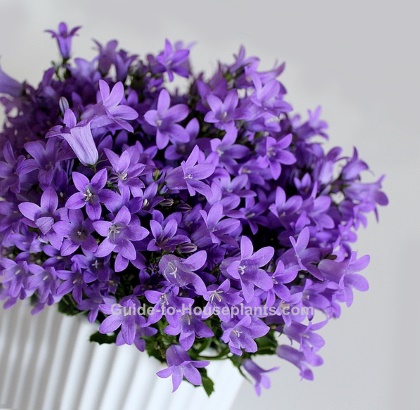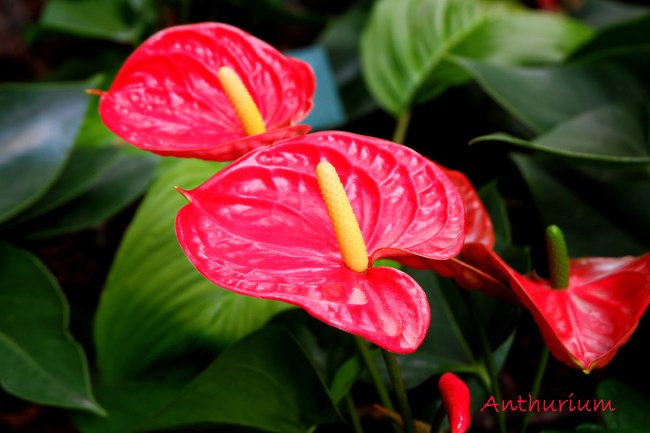Begonia Care Indoors
If you meet begonia care needs, you can expect months of spectacular flowers. Fortunately, it's pretty easy.
Here you'll discover how to grow Reiger begonia and other tuberous hybrids as houseplants. Find out what these beauties need to thrive year-round, plus how to get the most flowers and make it rebloom.

Get to Know Your Begonias
The begonia family includes more than 1,000 species and 10,000 hybrids and cultivars. Ongoing breeding improves these beautiful flowering house plants, giving the new hybrids more blooms than ever before.
Ideal for growing indoors, these xheimalis are hybrids of Begonia socotrana (discovered on the island of Socotra, off the coast of East Africa) and tuberous hybrids (with origins from South America). Often called winter-blooming begonia, ongoing breeding offers gorgeous new varieties that are available in bloom any time of year.
Begonias are full, bushy, and low-growing. Their thick, reddish stems grow from tuberous roots under the soil. How big do they get? These hybrid begonias typically reach a height of 12-18 in (30-45 cm).
Big, soft, dark-green leaves create a beautiful backdrop for abundant clusters of delightful flowers that are available in orange, white, yellow, red, and pink.
When buying a new plant, it's best to choose one that has good bud color and has just started to bloom. You'll sometimes find these plants labeled as Elatior or Reiger hybrids, but they include many varieties.
Tuberous begonias will go dormant after flowering, but you can bring them back into bloom, if you want. See "After-blooming begonia care" below to find out how.
Growing Begonias Year-Round
Keep the soil moist. Allowing it to dry out will leave the plant susceptible to disease. But you don't want soggy soil, either. Overwatering your begonia will cause leaves to wilt and turn yellow. Cut off any affected leaves as soon as you notice them. They're likely to rot and attract botrytis fungus.
Cut off spent flowers. Prune off dead flowers to keep your plant looking neat and to encourage more blooms.
Check foliage for fungus. Begonias are prone to powdery mildew -- a powdery white fungus that develops on its leaves. Spray an affected plant with a fungicide and keep it away from other plants to prevent it from spreading. Are leaves badly affected by mildew? Cut them off; it's better to lose leaves than to take a chance on the fungus spreading.
Watch for bugs. Fortunately, plants grown indoors aren't often bothered by pests. However, there are a few to watch for. Thrips may attack, causing distorted looking flowers and leaves. Cut off any affected parts of the plant. Spider mites are tiny, but you'll likely notice their fine webs. Perhaps the most dreaded of houseplant pests, mites can cause a lot of damage. Isolate any infested houseplant and treat it right away. If your plant is badly infested, get rid of it. Mealybugs look like white cotton-like specks; remove them with a cotton swab dipped in alcohol. Do not use oil-based insecticides on begonias to control pests, which will damage their soft foliage and flowers.
For more help on begonia pests and diseases, check this page from The American Begonia Society. You'll find pictures, tips and answers for preventing and treating problems.
After-Blooming Begonia Care
Begonias are challenging to maintain and regrow the following season, so they are often treated as temporary house plants. However, it's entirely possible to bring them back into bloom the following year.
- After flowering, cut back on watering so that the plant is barely moist, but not completely dry.
- Keep it away from light during this dormant period. In about 6-8 weeks, the foliage will die back.
- Cut off all the foliage, leaving 3 in (7.5 cm) stems.
- When new growth appears, remove the stems from the parent plant and pot them in new potting mix. You can discard the parent plant.

Indoor Begonia Care Tips
Light: Give your begonia plenty of bright light while it's blooming, but keep it out of direct sunlight which can scorch its leaves.
Water: Keep soil evenly moist, not soggy. Allow top inch of soil to dry between waterings.
Humidity: If relative humidity drops below 40%, use a cool-mist room humidifier or keep pot on a tray of wet pebbles to increase humidity. Don't mist begonias because their soft leaves are prone to mildew.
Temperature: Average room temperatures (65-75°F/18-24°C) are ideal. Don't expose begonias to temps below 55°F/13°C, because they are easily damaged.
Soil: Peat-based soilless mix such as African violet potting mix works well. Use a pot with drainage holes to prevent soggy potting medium.
Fertilizer: Begonias like a steady diet of fertilizer while they are growing and blooming. Feed plants every 3 weeks with a high-phosphorus liquid fertilizer diluted by half.
Propagation: Take 3-4 in (7-10 cm) stem tip cuttings at the beginning of the growing season and root in fresh potting mix.

